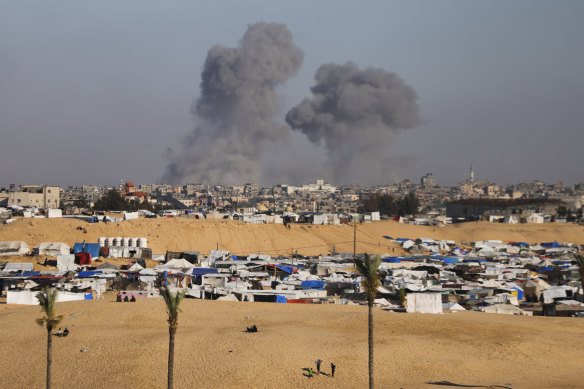
Instagram credits a user named “shahv4012” as the first person to use the image in an Instagram story template. The user did not immediately respond to overnight requests for comment from The Washington Post.
Rafah, now a focal point in the war between Israel and Hamas, had become a last refuge for about 1 million Palestinians fleeing the fighting elsewhere. Israel ramped up ground and aerial operations in the area in early May, leaving those displaced there with nowhere to go, activists say. As countries and human rights organisations urge for a halt in fighting and strikes on Rafah, the Israel Defence Forces this week expanded operations, pushing deeper into the area it says is central to Hamas operations – despite an order by the International Court of Justice for Israel to halt military operations there.

Smoke rises following an Israeli airstrike in Rafah’s east.Credit: AP
Why might people share an AI-generated image of Rafah?
Many on social media criticised the image as being an overly rosy depiction of a displacement area compared with the actual graphic footage coming from the scene, and that sharing it to raise awareness was “performative”.
Matt Navarra, a social media consultant, said the post’s uncontroversial nature might be what was driving the image’s massive reach.
“It doesn’t depict real-world violence. Although it feels sanitised, that is what has enabled it to have the level of viral reach that is has received so far,” said Navarra, adding that Instagram has not yet labelled the image to let users know it was produced using AI.
“People like to feel that they can help influence those that have power and authority to bring about change,” Navarra said. “Being part of a movement, even at the lowest level of engagement, people feel they have contributed in some small way towards a bigger cause.”
He added people might also share the image because it drove awareness on the issue, and media headlines, which could bring about change.
Sima Ajlyakin, a Cairo-based photographer, shared the photo on her Instagram account before deleting it, after questioning what posting the image would achieve. It was the real, gutting photographs that enabled those outside Gaza to witness what was happening inside, she said.
“At the end of the day, the photojournalists and the photographers [who] are on the ground, covering this, covering the atrocities that are happening for the whole world to see, especially on social media, these at the end of the day are the ones that raise so many alarms,” she said. “They’re the ones that raise all this worldwide anger … What does AI prove?”
She gave the example of another image that was widely shared from Monday’s attack: a video of a headless child, carried from under the armpits by a man standing outside a burning tent. This single image, Ajlyakin said, was especially powerful, even if it was not as widely shared on social media.
How do social media companies treat AI-generated images?
Earlier this year, Meta, which owns Instagram and Facebook, announced it would begin work to detect and label AI-generated images posted to its platforms. In April, the company said it would work to provide “transparency” and that it planned to start labelling AI-generated content in May. Instagram did not immediately return a request for comment for this story.
Simon noted that while generative AI tools “certainly make it easier” for people online to create custom-made images for specific topics or causes, traditional tools like Photoshop have also been and are widely used to do the same.
Where does the phrase ‘All Eyes on Rafah’ come from?
Loading
Richard Peeperkorn, the World Health Organisation’s representative in the West Bank and Gaza, said in February, “all eyes are on Rafah”, referring to the Israeli plan to launch a military incursion into the city. An Israeli military offensive there would be an “unfathomable catastrophe, further expanding the humanitarian disaster beyond all imagination”, he said.
It has since become a rallying cry for many organisations trying to amplify awareness of the living conditions in southern Gaza: Save the Children and Oxfam have both used the slogan, and Jewish Voice for Peace posted the message on X, hours after the strike.



























